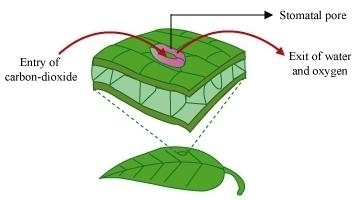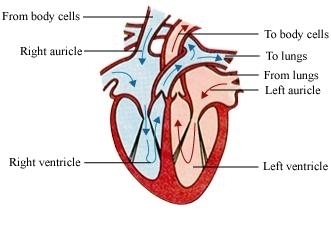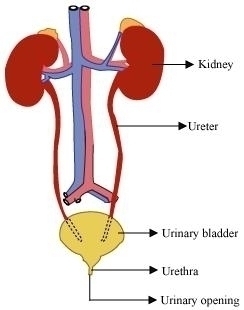Exercise : Solutions of Questions on Page Number : 131
Q1 : Match structures given in Column I with functions given in Column II.
|
Column I |
Column II |
||
|
(i) |
Stomata |
(a) |
Absorption of water |
|
(ii) |
Xylem |
(b) |
Transpiration |
|
(iii) |
Root hairs |
(c) |
Transport of food |
|
(iv) |
Phloem |
(d) |
Transport of water |
|
(e) |
Synthesis of carbohydrates |
Answer :
|
Column I |
Column II |
||
|
(i) |
Stomata |
(b) |
Transpiration |
|
(ii) |
Xylem |
(d) |
Transport of water |
|
(iii) |
Root hairs |
(a) |
Absorption of water |
|
(iv) |
Phloem |
(c) |
Transport of food |
Q2 : Fill in the blanks.
(i) The blood from the heart is transported to all parts of the body by the______.
(ii) Haemoglobin is present in ______ cells.
(iii) Arteries and veins are joined by a network of ______.
(iv) The rhythmic expansion and contraction of the heart is called ___ _ _.
(v) The main excretory product in human beings is ______.
(vi) Sweat contains water and ______.
(vii) Kidneys eliminate the waste materials in the liquid form called ______.
(viii) Water reaches great heights in the trees because of suction pull caused by ______.
Answer :
i) The blood from the heart is transported to all parts of the body by the _arteries__.
(ii) Haemoglobin is present in __red blood__ cells.
(iii) Arteries and veins are joined by a network of __capillaries__.
(iv) The rhythmic expansion and contraction of the heart is called __heart beat__.
(v) The main excretory product in human beings is __urea__.
(vi) Sweat contains water and __salts__.
(vii) Kidneys eliminate the waste materials in the liquid form called __urine__.
(viii) Water reaches great heights in the trees because of suction pull caused by __transpiration__.
Exercise : Solutions of Questions on Page Number : 132
Q3 : Choose the correct option:
(a) In plants, water is transported through
(i) xylem
(ii) phloem
(iii) stomata
(iv) root hair
(b) Water absorption through roots can be increased by keeping the plants
(i) in the shade
(ii) in dim light
- under the fan
- covered with a polythene bag
Answer :
(a) (i) xylem
(b) (iii) under the fan
Q4 : Why is transport of materials necessary in a plant or in an animal? Explain.
Answer :
Transport of materials is necessary in both plants and animals as every cell needs a regular supply of nutrients and oxygen for releasing energy through respiration. The food that we eat is broken down into smaller components to be absorbed by the cells. The oxygen that we inhale is also transported to all the cells of the body. Our body also requires a constant removal of waste materials such as carbon dioxide. For the transport of all these materials (food, oxygen, and wastes), our body has a specialised transport system. Similarly, in plants, the transport of water and food is accomplished with the help of a complex transport system.
Q5 : What will happen if there are no platelets in the blood?
Answer :
If there are no platelets in the blood, then the blood would not be able to clot. A clot is formed because of platelets. They release blood clotting chemicals at the site of injury. These chemicals form a clot and prevent further bleeding.
Q6 : What are stomata? Give two functions of stomata.
Answer :
Stomata are tiny pores present on the surface of a leaf.
Functions of stomata:
(a) Stomata help in the exchange of gases.
(b) Evaporation of water from the leaf surface occurs through stomata.

Q7 : Does transpiration serve any useful function in the plants? Explain.
Answer :
Transpiration is the evaporation of water from the plants. The water evaporates through the stomata present on the surface of the leaves.
Transpiration is mainly responsible for the loss of water that was absorbed by the plants. However, it is important for plants as it helps in the movement of water to the top of tall trees. As a result, it helps in the distribution of water throughout the plant body. It also helps in cooling the plant.
Q8 : What are the components of blood?
Answer :
The main components of blood are
(i) Red blood cells (RBCs): Red blood cells are the most abundant cells in the blood. These cells contain a red pigment called haemoglobin. It is the haemoglobin which carries oxygen and transports it to all parts of the body.
(ii) White blood cells (WBCs): WBCs are colourless cells without haemoglobin. They fight against infections and protect the body from foreign particles such as germs and bacteria.
(iii) Platelets: Platelets are the smallest cells in the blood. The main function of platelet is to prevent bleeding.
Q9 : Why is blood needed by all the parts of a body?
Answer :
Blood is needed by all parts of the body as it is an important part of the transport system of our body. It performs the following important functions:
(i) It transports O2 from the lungs to all the body cells.
(ii) It carries CO2, a waste product back to the lungs so that it can be exhaled easily.
(iii) It transmits heat, thus regulating the body temperature.
(iv) It also fights off diseases and infections.
Q10 : What makes the blood look red?
Answer :
The presence of haemoglobin, a red pigment in the red blood cells (RBCs) makes blood appear red in colour. The haemoglobin carries oxygen and transports it to all the parts of the body.
Q11 : Describe the function of the heart.
Answer :
The human heart is divided into four chambers. The upper two chambers are called right and left atrium and the lower two chambers are called the right and left ventricles. Right atrium receives carbon dioxide-rich blood from the body. Blood from right atrium enters the right ventricle, which contracts and pumps the blood to the lungs.

Flow of blood in the human heart
On the other hand, oxygen rich blood from the lungs returns to the left atrium. From the left atrium, blood enters left ventricle. Left ventricle contracts and pumps the blood to all parts of the body.
Hence, the rhythmic contraction and expansion of various chambers of the heart maintains the transport of oxygen to all parts of the body.
Q12 : Why is it necessary to excrete waste products?
Answer :
All cells of our body produce waste products. These waste products are toxic to the body and therefore need to be excreted out. This process of removing waste products produced in the cells of living organisms is called excretion.
Q13 : Draw a diagram of the human excretory system and label the various parts.
Answer :

Human excretory system